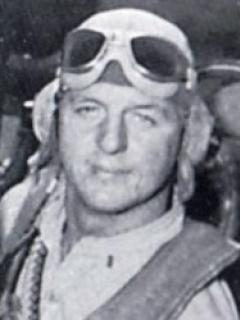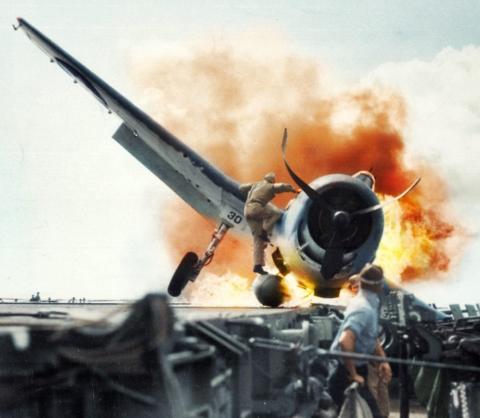JOHNSON-BYRON
BYRON MILTON JOHNSON

LT

ICONIC PHOTOGRAPH FROM WWII
On November 10, 1943, Ensign Byron Milton Johnson, departed Barber’s Point, Hawaii, with a flight of Hellcat F6F-3 fighters of Fighting Squadron Two (VF-2) for a routine exercise to join the carrier USS Enterprise (CV-6) at sea. Upon approaching Enterprise, the Hellcat developed engine trouble and Johnson requested an emergency landing. He was waved off three times as he struggled to maintain control and on the third pass the Hellcat inadvertently caught the third arresting gear wire and Johnson’s Hellcat was slammed into the deck, coming to rest in the port catwalk. The crash crushed the external belly fuel tank and leaking gasoline was ignited by sparks from the propeller which bent itself on the deck. The hard landing also jammed the closed canopy, shearing the retaining pin and Johnson was unable to force the canopy open.
The Enterprise catapult officer, Lieutenant Walter Lewis Chewning, seeing Johnson’s plight, sprinted from the catwalk, climbed on top of the burning belly tank and succeeded in forcing open the canopy and pulling Johnson to safety. Chewning reached the burning aircraft well before the fire fighting crew who reportedly was hesitant to approach the burning aircraft as it carried live ammunition. In view of the incredible bravery exhibited by Chewning in rescuing Johnson who received only slight injuries, Chewning was awarded the Navy and Marine Corps Medal. The photograph of Chewning standing on the belly tank of the burning aircraft has become an iconic picture of World War II. Because of wartime censorship, the picture was not made public until January 1945 and has been used hundreds of times since then. The photograph reportedly ranks 23rd among the 100 greatest military photographs ever taken.
Johnson joined the Navy shortly after Pearl Harbor and received his Pilot’s Wings in April 1943. He remained with VF-2 until the end of the war during which he became a fighter ace credited with eight victories. After his release from the Navy he returned to Sidney, Nebraska, where he and a friend started a local flying service and was also instrumental in having the municipal airport built at Sidney in 1947. Johnson took advantage of the G.I. Bill and returned to school, graduating with a law degree in 1952. He enjoyed a successful and fulfilling law career including 35-years in private practice. He also served four years as Scotts Bluff County Attorney and was elected to three terms as Public Defender of Scotts Bluff County, retiring in 2000. He died February 20, 2005, and is buried at West Lawn Cemetery in Gering, Nebraska.
Submitted by CDR Roy A. Mosteller, USNR (Ret)


